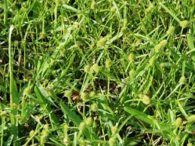Over the past few years, the perennial weed known as kyllinga has become a real issue for us in New Jersey. There are 2 types of kyllinga – green and false kyllinga. False kyllinga is a weed that has come up from the south. This is a warm season weed. Ideal conditions for the growth of this weed would be lawn areas that receive a lot of sunlight and are poorly drained and/or over irrigated.
This weed can also be transferred from other lawns using mowers with decks that are not properly maintained and it can just be spread by the wind. Warm soil temperatures, consistently 60 degrees or warmer, drive this weed out of its dormancy. As the weather gets warmer, the re-growth of kyllinga begins. These weeds are lateral growing and thrive under the lawn making it difficult to see with the naked eye.
When kyllinga matures, you will see a very unsightly weed in your lawn, landscape or both. Left untreated this invasive weed will spread in a “mat form” and literally take over your existing turf grass.
Unfortunately, we are limited on herbicide options that will control this extremely invasive weed. Currently, I am aware of 2 herbicides most commonly used that have any affect on it: sedgehammer (halosulfuron) and dismiss (sulfentrazone). If the affected area is large, several applications will be required.
To help prevent your lawn from getting this weed, here are a few recommendations I suggest to my clients. Make sure your irrigation controller is properly set, adjusted and monitored accordingly. This is a good example of why I advise my clients to never adopt a philosophy of “set it and forget it” when it comes to your irrigation system. Also, if you have poor drainage, you should seek remedies to eliminate that issue.
Lastly, always make sure you are using a reputable lawn care company to cut and maintain your lawn. Sometimes the cheaper cut is not always the best cut because as I said earlier, if the mowers are not properly maintained from lawn to lawn you could “catch” this weed from someone else’s lawn. That cheap cut could cost you your lawn. Just food for though!


Dear sir,
I am having a serious problem with Kyllinga. I have a Bermuda grass lawn and perform all of my own maintenance. Having grown up on my families sod farm I am very experienced in growing a healthy Bermuda lawn.
I used Sedgehammer as a pre-emergent. Sedgehammer is very expensive and it did eliminate any and all nut sedge but the Kyllinga has become a problem. I have resorted to getting on my hands and knees to pull them out by hand. Certainly a chore.I live in Louisiana about 50 miles north of New Orleans.
As the summer starts to close out I am in scramble mode to have my lawn filled in before it goes dormant. I am the type of person that cannot stand to see a single weed in my yard so one can imagine my disgust over the Kyllinga.
Thank for the information I will try your other suggestion and see how it turns out.
Hi Jim,
I am sorry to hear you are having such an issue. It has been extremely bad for us here in Jersey as the weather this season was exactly what the weed needed to harvest. If I may make some recommendations for you. Please do not hand weed as with nutsedge if you pull it, it will spread, the same for kyllinga. I would check with your local site one supplier or wherever you may purchase herbicide products from to try dismiss, celero or a granular product called echelon which is what we use for our beginning season crabgrass applications, but it has sulfentrazone in it. Please make sure that any product you apply will be safe to use on your Bermuda grass. We also use an herbicide called T-Zone which also kills it, but again make sure it will not affect Bermuda grass.
Your area may call for different products than we use because we are a cool season turfgrass. The best control we have been able to get (which is some control) is by alternating our products based on time of season and whether a pre-emergent or post emergent is applied.
I am sure you should be able to check with a college coop extension program that may give you some insight also.
Last and most important if you do the applications yourself follow the recommendations on the product label. I am sure you already know this but if mix at a higher rate than recommended the product may not even work.
Good luck to you and I hope you find the combination that will work well.
Best regards,
John